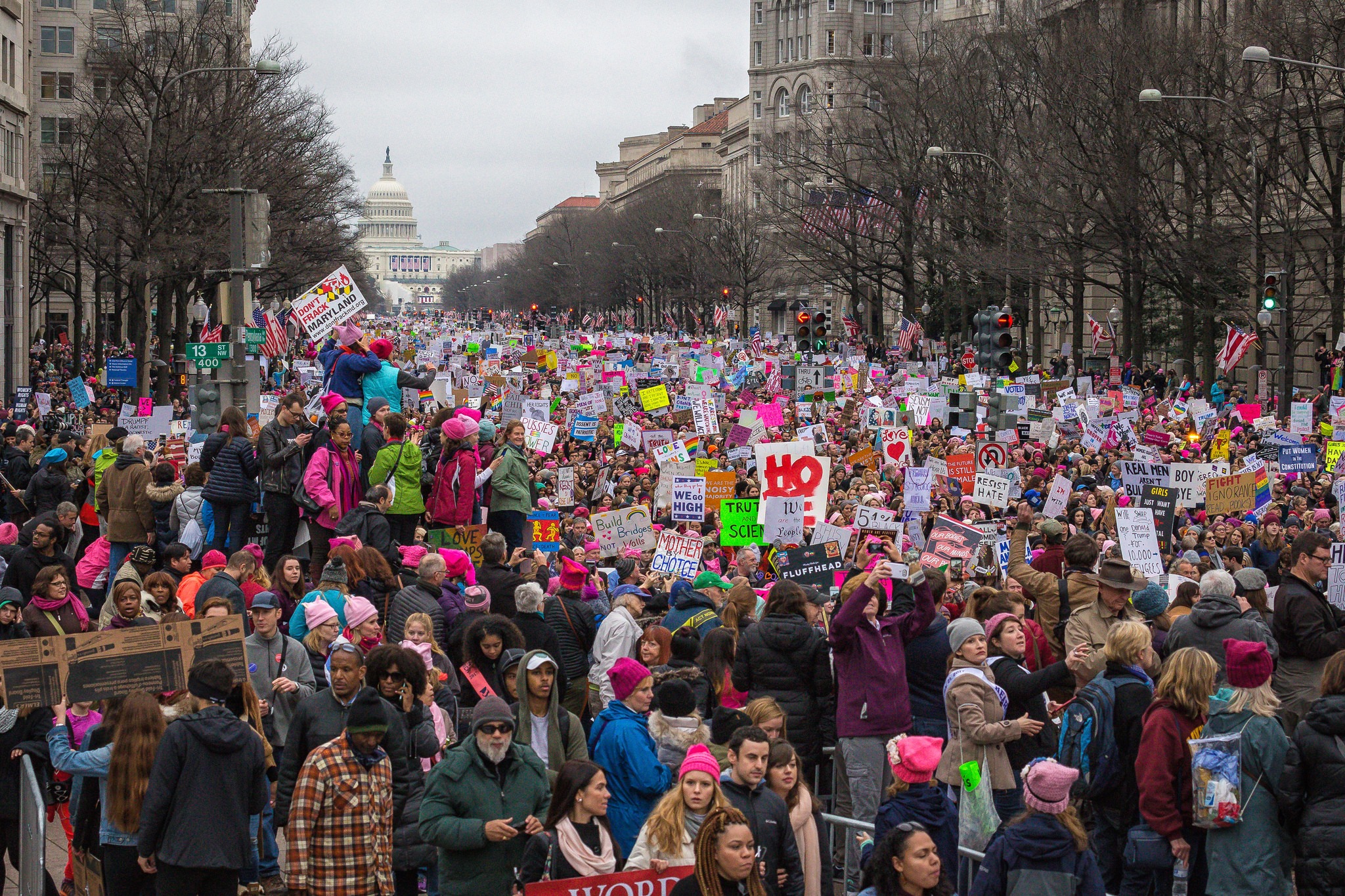Less than 24 hours after the presidential inauguration, the women’s protest it inspired—the largest demonstration in U.S. history, a massive uprising that sent three million people into the streets in more than 500 American cities as well as all seven continents, including Antarctica—felt like stepping into a time warp.
President Trump’s inauguration—like his family and the angry movement that propelled him into the White House on the twin jet engines of nostalgia and grievance—was very white and very old-fashioned, with visual arm candy supplied by model-thin women teetering on lethally high heels as they paraded their surgically enhanced physical perfection before the cameras. Such picture-ready polish doesn’t come easy; Melania Trump is reportedly installing a so-called “glam room” at the White House to facilitate the maintenance of the Trump women’s hard-earned achievement of photo-shoot-worthy makeup and lavish rivulets of unnaturally colored country-rock-star curls.
The surreal feeling of being transported back in time was enhanced by the new First Lady’s decision to channel the Jackie Kennedy of half a century ago by wearing an arrestingly stiff outfit that encased her stalk-like neck in a wrap-around cone that talk show host Stephen Colbert subsequently described as a “blue Ralph Lauren head transportation device.” Her feet were clad in matching powder-blue pumps as exquisitely color-coordinated as the high heels that teenaged girls used to dye to match their formal gowns at ballroom dancing school in the 1960s.
No matter their circumstances, all women know how impractical such stereotypically feminine get-ups are when one is required to deal with reality instead of tottering a few steps between the limousine and the seated black-tie gala. If any of the Trump women had been forced to run on their terrifyingly high heels, some would surely have fallen and been trampled by hordes of men in sensible shoes, nimbly escaping any threat.
But when millions of women took to the streets the following day, the differences couldn’t have been more dramatic. The protestors were old and young, fat and thin, black and white and tan and every other shade of the human rainbow, native-born and immigrant, pious and secular, motivated by outrage over causes that ranged from health care to pay equity to the stunning contempt for women routinely displayed by the incoming president.
Whether grandmothers or mothers or schoolgirls or toddlers, they wore pants and running shoes that enabled them to stand and walk for hours. Instead of worrying about whether their hair was frizzing or their curls were drooping, they sported pink pussy hats in defiant rejection of the patriarchal values that sanction men’s “right” to grab the genitalia of any women they desire.
The protestors’ physical diversity manifested the family of humankind as people actually experience it, in all its sublime variety and glorious imperfection.
Instead of mocking the disabled, as Donald Trump did during the campaign, marchers helped those who arrived in wheelchairs or hobbled on crutches. Whether borne in baby backpacks or wielding signs that said “Now you’ve pissed off grandma,” their physical diversity manifested the family of humankind as people actually experience it, in all its sublime variety and glorious imperfection.
In striking contrast, the Trump women presented themselves as living monuments to an artificially enhanced historical archetype that comes as naturally as Chinese foot-binding, and proves just as crippling when its constraints are imposed on real life. The sense of confinement and rigidly enforced artifice inspired by Mrs. Trump were so overwhelming that signs at the Women’s March bore messages that included:
“Free Melania,”
“Melania, blink twice if you want us to save you.”
“Melania looks like a fembot made of silicon instead of a carbon-based life form,” observed a male doctor I know as we watched the inauguration. “If you opened up the back of her head, do you suppose you’d find a lithium battery with a sign that says, ‘Replace every six months’?”
Ever since the march on Saturday, the pundits have filled the airwaves with speculation about What It All Means for the political power of women and the prospects for a Trump White House already under siege for perpetrating egregious falsehoods—which seemed as apt a metaphor for the administration’s view of women as for its retrograde approach to other issues. But all the future-focused blather misses the point, as was made radiantly clear by a video shot by an accidental bystander with a dying cell phone who nonetheless managed to capture an extraordinary event at the Washington march.
Israeli-American film director Alma Har’el happened upon a guerilla flashmob of a cappella singers performing a thrilling new song called “Quiet” that was composed, arranged and led by Los Angeles musical artist MILCK.
“These women are from different states and never met until today,” Har’el wrote in her original post on Sunday, which has since been viewed more than eight million times as it instantly went viral. “They practiced this song online. I was crying the whole time I filmed this.”
The lyrics, which were quickly hailed as the anthem of the Women’s March, made its purpose crystal clear.
Put on your face
Know your place,
Shut up and smile
Don’t spread your legs
I could do that
But no one knows me no one ever will
If I don’t say something, if I just lie still
Would I be that monster, scare them all away
If I let them hear what I have to say
I can’t keep quiet, no
I can’t keep quiet, no
A one woman riot, oh
The Women’s March constituted the real-time verdict of millions of women, which is now being shared all over the planet in a stunning rejection of unquestioning submission to male dominance that is spreading like wildfire: “I can’t keep quiet/For anyone/Any more.”
Leslie Bennetts is a longtime journalist who has covered presidential politics since the 1970s and a best-selling author whose latest book is Last Girl Before Freeway: The Life, Loves, Losses and Liberation of Joan Rivers.







I was at a memorial service rather than the march on Saturday, but I’ve been rejuvenated by the videos and photos coming from ALL OVER THE WORLD that sends a clear message, not just to the POTUS, but to all men. They need to sit up and pay close attention to the change taking place around them. There is no going back in time. Together, with out without POTUS, we move forward.
Thanks, Ms. Bennetts. I smile, and laughed, and teared up reading your piece.
Hopefully this will inspire everyone to get involved. If its only now back to the health spas and pilates classes for the women, and fancy microbrews and golf courses for the guys, then the march will be looked at ultimately just a token of symbolism. Now we all must do our part as individuals.
While the core of the article is sound, I think the condescension in the first part may prevent some from appreciating the important points of the article.
The attitude that we know better and everyone else is a fool is frighteningly like the Trump camp.
It is long past time that every woman is appreciated for her wit, knowledge, experience, skill, and humor, as it is long past time for us to clearly recognize that we all have something valuable to contribute, and that alone we will fail, just as together we will prevail.
Diversity is not an option – it is essential!